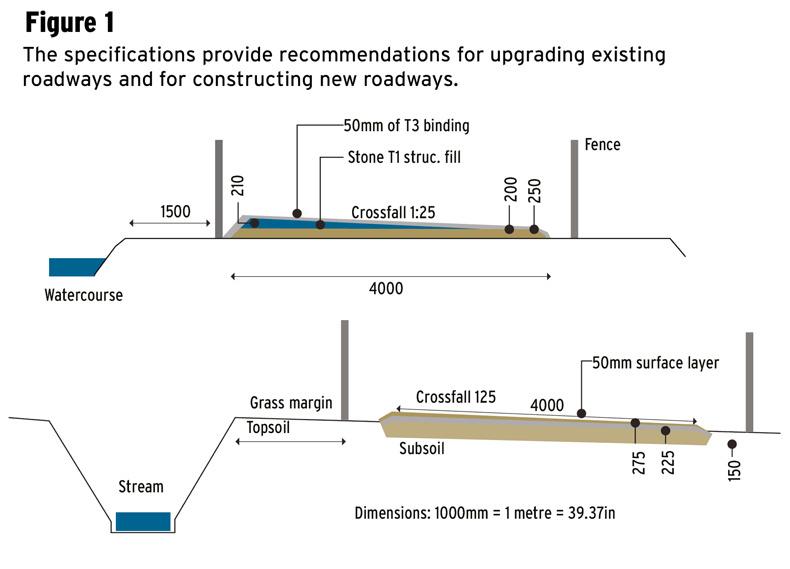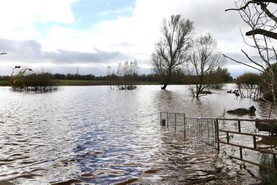The Department of Agriculture and Food recently updated its minimum specifications for farm roadways (S.199). The specifications generally relate to requirements that must be followed to secure grant aid but are also best-practice guidelines for completing tasks irrespective of grant aid.
The updates relate to two main areas – preventing runoff from entering watercourses and abiding by health and safety criteria.
Preventing runoff of soiled water from farm roadways to waters is now a statutory requirement governed by the SI No. 605 of 2017; Good Agricultural Practice for the Protection of Watercourses. It states that from 1 January 2021, there will be no direct runoff of soiled water from farm roadways to waters.
Options listed to prevent overland sediment and nutrient runoff from farm roadways to waters include the cambering of the roadway to direct water to one side and away from the watercourse, putting in place a wall of soil along the side of the roadway and piping runoff to a sediment trap/pond or directly on to land and, where required, the relocation of roadways away from fields containing watercourses.
The specifications also advise that the requirement to divert runoff from farm roadways away from ditches will not apply where a drainage ditch is managed as a natural water retention feature or sediment trap.
Roadway layout
The advice, where at all possible, is to avoid laying a new roadway adjacent to a watercourse.
Where there is no other option, then a grass margin of 1.5m must be maintained between the roadway fence and the top of the watercourse.
This is detailed in Figure 1, which demonstrates how the camber of the roadway can be upgraded in an existing roadway or installed from new to direct water away from a watercourse.
A fence must be erected on both sides to prevent access to livestock to the watercourse from the roadway.
The specifications state that a roadway that slopes to one side is easier to construct and that livestock spread out better where the road cambers to both sides from the middle.
However, this is not feasible alongside a roadway without installing other means of preventing runoff.
The width of the roadway recommended depends on the herd size and is listed in Table 1. The specifications advise that dairy farmers using automatic milking systems can ignore this table.
It is advised to allow an additional 1m to the width of the roadway nearest the farmyard and to erect the fence approximately 0.5m from the edge of the roadway. This will encourage livestock to use the full width of the roadway, while at the same time prevent them from walking along the grass margin. It states that where cows are trying to walk in the grass margin as opposed to the roadway means the fence may be too far from the edge or that the surface is inadequate and forcing cows to try and walk on the margin.
Sediment trap
Where roadways are located adjacent to a watercourse and it is not possible to slope it away from a watercourse, then the runoff must be piped away.
The specifications state it may be necessary in some cases such as poorly drained soils to incorporate a sediment trap or settlement pond with these areas catering for the slow attenuation of waters via drainage through the soil.
The size of these ponds is dependent on the topography in the area. The advice is to locate them at least 6m from a gateway and to fence them adequately for safety while providing access for cleaning, if required.
Dry, closed drains with no outfall to other waters could also accommodate runoff water and act as suitable soakage areas. If none of these options are available or there is no land available for attenuation, then there will be no option but to collect runoff for land spreading (providing 10 days’ capacity).
Crossings and bridge design
Road crossings of aquatic zones (defined as a permanent or seasonal river, stream or lake shown on an ordnance survey 6in map) must be kept to a minimum. Where bridges are constructed they must be designed to have a clear span over the water course.
If a culvert is used then only a single pipe should be used to prevent any blockage by debris. The culvert should be embedded 200mm into the stream bed while all bridges and culverts shall be designed to take the maximum flood flow of a watercourse.
Where roads are running in the middle of fields and on reasonably level surfaces, then there is likely to be little remedial work required on existing roads. Only roads that are near watercourses will need significant work and, in certain circumstances, need to be relocated to ensure compliance with the regulations. This includes roadways that are adjacent to watercourses that are dry for considerable periods at a time. Where new roadways are being constructed, then every effort should be made to keep them away from watercourses. Health and safety
Applicants are advised to familiarise themselves with the provisions of the Safety, Health and Welfare at Work Act 2005 and the regulations in the Health, Safety and Welfare at Work (Construction) Regulations (2013). It is highlighted that farmers or applicants have significant responsibilities in relation to any construction work being planned and the requirement to appoint in writing a competent project supervisor for the design process and similar for the construction stage. If a farmer or applicant is carrying out works, then they are advised to seek competent advice.
The Department of Agriculture and Food recently updated its minimum specifications for farm roadways (S.199). The specifications generally relate to requirements that must be followed to secure grant aid but are also best-practice guidelines for completing tasks irrespective of grant aid.
The updates relate to two main areas – preventing runoff from entering watercourses and abiding by health and safety criteria.
Preventing runoff of soiled water from farm roadways to waters is now a statutory requirement governed by the SI No. 605 of 2017; Good Agricultural Practice for the Protection of Watercourses. It states that from 1 January 2021, there will be no direct runoff of soiled water from farm roadways to waters.
Options listed to prevent overland sediment and nutrient runoff from farm roadways to waters include the cambering of the roadway to direct water to one side and away from the watercourse, putting in place a wall of soil along the side of the roadway and piping runoff to a sediment trap/pond or directly on to land and, where required, the relocation of roadways away from fields containing watercourses.
The specifications also advise that the requirement to divert runoff from farm roadways away from ditches will not apply where a drainage ditch is managed as a natural water retention feature or sediment trap.
Roadway layout
The advice, where at all possible, is to avoid laying a new roadway adjacent to a watercourse.
Where there is no other option, then a grass margin of 1.5m must be maintained between the roadway fence and the top of the watercourse.
This is detailed in Figure 1, which demonstrates how the camber of the roadway can be upgraded in an existing roadway or installed from new to direct water away from a watercourse.
A fence must be erected on both sides to prevent access to livestock to the watercourse from the roadway.
The specifications state that a roadway that slopes to one side is easier to construct and that livestock spread out better where the road cambers to both sides from the middle.
However, this is not feasible alongside a roadway without installing other means of preventing runoff.
The width of the roadway recommended depends on the herd size and is listed in Table 1. The specifications advise that dairy farmers using automatic milking systems can ignore this table.
It is advised to allow an additional 1m to the width of the roadway nearest the farmyard and to erect the fence approximately 0.5m from the edge of the roadway. This will encourage livestock to use the full width of the roadway, while at the same time prevent them from walking along the grass margin. It states that where cows are trying to walk in the grass margin as opposed to the roadway means the fence may be too far from the edge or that the surface is inadequate and forcing cows to try and walk on the margin.
Sediment trap
Where roadways are located adjacent to a watercourse and it is not possible to slope it away from a watercourse, then the runoff must be piped away.
The specifications state it may be necessary in some cases such as poorly drained soils to incorporate a sediment trap or settlement pond with these areas catering for the slow attenuation of waters via drainage through the soil.
The size of these ponds is dependent on the topography in the area. The advice is to locate them at least 6m from a gateway and to fence them adequately for safety while providing access for cleaning, if required.
Dry, closed drains with no outfall to other waters could also accommodate runoff water and act as suitable soakage areas. If none of these options are available or there is no land available for attenuation, then there will be no option but to collect runoff for land spreading (providing 10 days’ capacity).
Crossings and bridge design
Road crossings of aquatic zones (defined as a permanent or seasonal river, stream or lake shown on an ordnance survey 6in map) must be kept to a minimum. Where bridges are constructed they must be designed to have a clear span over the water course.
If a culvert is used then only a single pipe should be used to prevent any blockage by debris. The culvert should be embedded 200mm into the stream bed while all bridges and culverts shall be designed to take the maximum flood flow of a watercourse.
Where roads are running in the middle of fields and on reasonably level surfaces, then there is likely to be little remedial work required on existing roads. Only roads that are near watercourses will need significant work and, in certain circumstances, need to be relocated to ensure compliance with the regulations. This includes roadways that are adjacent to watercourses that are dry for considerable periods at a time. Where new roadways are being constructed, then every effort should be made to keep them away from watercourses. Health and safety
Applicants are advised to familiarise themselves with the provisions of the Safety, Health and Welfare at Work Act 2005 and the regulations in the Health, Safety and Welfare at Work (Construction) Regulations (2013). It is highlighted that farmers or applicants have significant responsibilities in relation to any construction work being planned and the requirement to appoint in writing a competent project supervisor for the design process and similar for the construction stage. If a farmer or applicant is carrying out works, then they are advised to seek competent advice.






 This is a subscriber-only article
This is a subscriber-only article










SHARING OPTIONS: